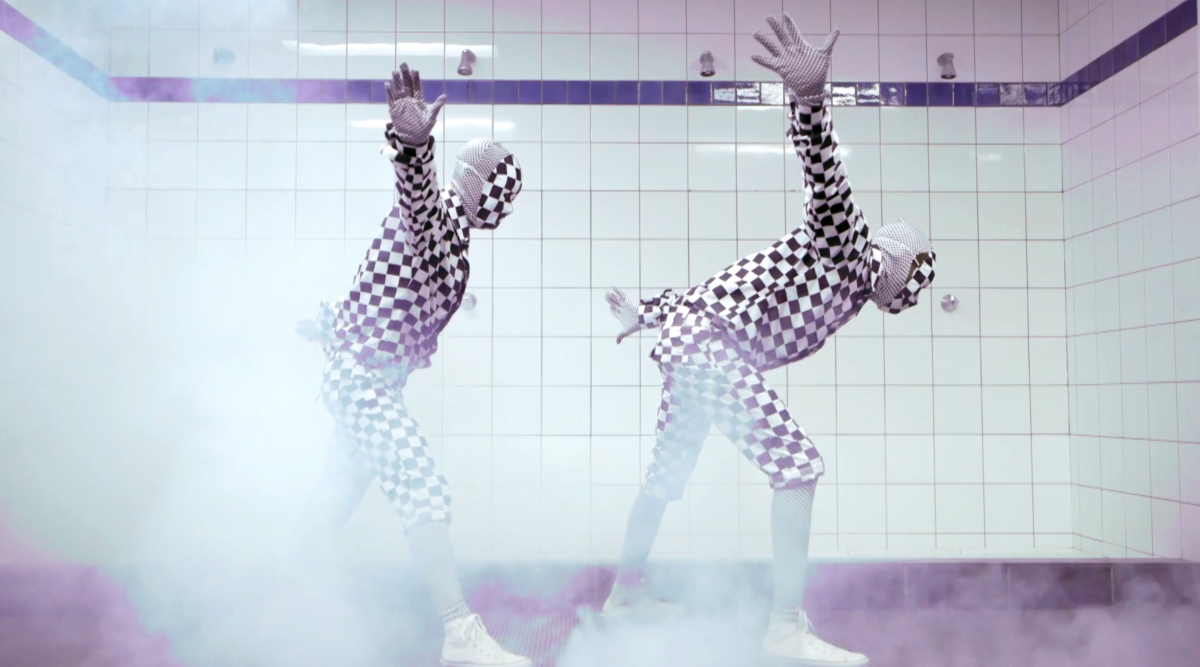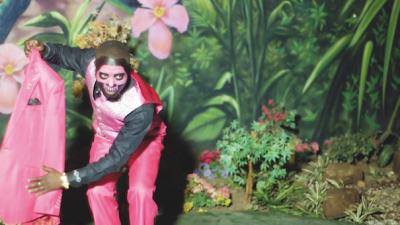M.I.A. choreografiert Flüchtlinge, Antony erwärmt das Klima im Club, und Kate Tempest ruft schon mal den Aufstand aus: Drei spektakuläre neue Songs schliessen das politischste Popjahr seit langem ab.
Diese Ungeduld ist ein Versprechen. Irgendwann im nächsten Jahr soll ein neues Album von Kate Tempest erscheinen, der 29-jährigen Rapperin aus dem Süden von London. Doch dieses eine Stück duldete offenbar keinen Aufschub, es musste raus. Und so klingen sie auch, die 153 Zeilen oder 823 Wörter von «Europe Is Lost», wie ein Affekt. Man hört das Keuchen einer Indiegitarre, das Pumpen eines Grooves, und darüber schüttet sich in viereinhalb Minuten eine junge Frau über die Welt aus, in einer hastig schnappenden, dringenden Wortgewalt, die an die Sex Pistols oder an Public Enemy denken lässt.
Und an D’Angelo. Genau ein Jahr ist es her, dass der damals fast vergessene R&B-Star unter dem Eindruck der neuesten Rassenunruhen in den USA die zwölf Songs von Black Messiah viel früher herausbrachte, als es geplant war. Und damit ein Popjahr lancierte, das so politisch wurde, wie man es kaum mehr für möglich gehalten hatte. Im Frühling erschien To Pimp A Butterfly von Kendrick Lamar, das jede vernünftige Bestenliste von 2015 anführen wird; aber auch andere Rapper wie Earl Sweatshirt oder Dr. Dre blickten auf ihren Platten auf eine afro-amerikanische Community, die desillusioniert und wütend an der Strasse stand und weisse Kreidelinien sah, die tote schwarze Körper umrissen: «All we wanted was a chance to talk», hatte D’Angelo gesungen: «Instead we only got outlined in chalk.»
Fünfzig Jahre, nachdem Präsident Lyndon B. Johnson zum Gesang von Sam Cooke, Otis Redding oder John Coltrane ein neues Wahlgesetz unterschrieben und damit die rassistischen Paragrafen aus dem 19. Jahrhundert ausgelöscht hatte, triumphierte 2015 die Black Music erneut als Soundtrack zum Streben der afro-amerikanischen Gesellschaft. Als kreative Zelle einer neuen Black Consciousness empfahl sich dabei Brainfeeder, ein kleines Plattenlabel in Los Angeles, das Jazz, Hiphop und elektronische Tanzmusik als Teile derselben Tradition feiert und ineinander verschlauft.
Komplex ist nicht schwierig
Einige der Hausmusiker bei Brainfeeder standen im Studio, als Kendrick Lamar sein Meisterwerk einspielte. So der Saxofonist Kamasi Washington, der mit dem monumentalen The Epic jenes Jazzalbum herausbrachte, das 2015 jedes andere in den Schatten stellte. Und das nicht, weil es drei CDs umfasst; eher schon, weil auch für Washington selber gilt, was er über Lamar gesagt hat: «Seine Platte hat die Annahme gekillt, dass die Menschen dumm sind und nur ganz simple Musik verstehen können.» An Konzerten von Kamasi Washington, wird berichtet, tanzt ein halb weisses, halb schwarzes Publikum zum komplexen Flow des Jazz. Genau, es tanzt.
Dass sich ein Argument auch tanzen lässt, ist tatsächlich ein entscheidender Faktor für politischen Pop. Es gehörte zu den traurigsten Aspekten der in vieler Hinsicht traurigen Occupy-Bewegung von 2011, dass ihre Demonstrationen von Protestonkeln wie Pete Seeger und David Crosby begleitet wurden, die zu akustischen Gitarren und Händeklatschen noch einmal alte Kampflieder wie «We Shall Overcome» und «Teach Your Children» aufführten.
Das beeindruckenste politische Lied der letzten Jahre war darum wohl «Gun Has No Trigger» der Dirty Projectors: Zum einen, weil es gegen die Protestunfähigkeit seiner Generation protestierte und die Selbstaufgabe als letztmöglichen Akt des Widerstands ausrief. Und mehr noch, weil es eine fantastisch griffige Popsingle war.
Daneben aber untersuchte die Popmusik zuletzt vor allem Fragen des Identitätsmangements: Das brillante Debüt von FKA Twigs, auf dem sie die moderne, elektronische eingedatete Existenz einfing, war neben dem 100-Millionen-Deal von U2 mit Apple das bedeutendste und meistdiskutierte Ereignis des Popjahres 2014. Vielleicht ist die Zeit für die Desillusion und den Eskapismus in die Innerlichkeit jetzt abgelaufen; und die zwölf schiessbereiten Sicherheitsleute, die Bob Dylan, Autor sinnträchtiger Lieder wie «With God On Our Side», an seinen Konzerten neuerdings auf der Bühne und im Parkett platziert, sind dafür das offensichtlichste Fanal.
Die Hitze steigt
Und doch blieb es erstaunlich, als in den ersten Dezembertagen, wenige Wochen nach der Terrorattacke auf das Konzert der Eagles of Death Metal im «Bataclan» in Paris, nacheinander drei explizit politische Songs erschienen. Noch erstaunlicher: Alle drei sind einigermassen komplex und doch tanzbar. Und am erstaunlichsten: Alle drei klingen fantastisch.
So hat sich Antony, bekannt als Grosspathetiker am Grand Piano, für seine neue Single nicht nur eine neue Identität namens Anohni zugelegt, sondern auch einen sehr coolen Produzenten. Hudson Mohawke hat für «4 Degrees» aus sauren Synthesizern und adipösen Bläsern einen monströsen Clubtrack gebaut, in dem es nicht mehr um grenzesoterisches Engelszeug geht, sondern um den eigenen kleinen, miesen Beitrag zur Klimaerwärmung: «I wanna burn the sky / I wanna burn the breeze / I wanna see the animals die in the trees.» Der Song begleitet – unbeabsichtigt – einen Brief, den 337 Künstler zuhanden des Klimagipfels in Paris unterzeichnet haben, darunter viele Popmusiker wie Björk, David Bowie, Courtney Barnett oder Thom Yorke.
Ja, wir schaffen das
Das Schreiben zeugt von einem politischen Selbstbewusstsein, wie man es in der Szene höchstens von Bono kannte (der nicht zu den Unterzeichnern gehört): «Die Kreativindustrie drückt kulturelle Werte nicht nur aus, sondern formt sie auch», heisst es: «Wir beeinflussen, wie die Leute denken und welche Entscheidungen sie treffen.» Die Künstler stellen im Brief nicht nur Forderungen, sondern bieten auch ihre Mitarbeit an – und enden so, als sässen sie bereits im Oval Office: «We must, we can, and together we will act.» Überzeugender klingt Hudson Mohawke: Mit wagnerianischem Druck steigert er im Track von Anohni die Hitze; derart, dass einem bald der Atem stockt.
Auch M.I.A. beschränkt sich weise darauf, Politik mit ihren popkulturellen Mitteln zu machen. Im Video zu «Borders», ihrer neuen Single, singt und tanzt sie vor einer Armada afrikanischer Boat People – was ihr zuverlässig den Vorwurf eingebracht hat, das Elend der Flüchtlinge auszubeuten. Das kann man wie immer so sehen. Doch die Sri Lankesin, die mit neun Jahren mit ihren Eltern nach England geflohen ist, weiss erstens, wie sich eine Flucht anfühlt, und zweitens, wie Massenkultur geht.
Also choreografiert sie die Schwarzafrikaner auf Booten und an Grenzzäunen zu coolen Ornamenten der Ohnmacht. Dazu zittert der Beat, als sei er vom Kriegstremor befallen, und in fast kindlichen Abzählreimen fragt M.I.A., worum es eigentlich schon wieder ging in so einem Leben, nachgerade im popkulturellen: «We’re representing peeps.» Es ist, als führe die 40-Jährige ihr Publikum behutsam auf Feld eins der Politik. Genau, wie war das: Teach your children well, nur klingen tut es jetzt viel besser.
Ein Aufstand wird kommen
Auch Kate Tempest scheint gewillt, dahin zu gehen, wo es weh tut. Ihr «Europe Is Lost» ist ein berauschter Affront gegen die Zumutungen der westlichen Gesellschaft, aus deren Mitte die Leute unbemerkt herausfallen: «Nobody noticed», rappt sie, «Well actually, some of them noticed / you could tell by the emoji they posted.» Auf die rechten Politiker um David Cameron prasseln die Zeilen also nur in den schwächsten Momenten des Songs herunter; brutaler und besser ist Tempest da, wo sie die neoliberalen Kinder in ihrer Lethargie und in ihren Partykellern anranzt. Nur um schliesslich zu prophezeien: «I am quiet / Feeling the onset of riot.»
Und man fragt sich: Wird dieses dringende Lied zur Fanfare für 2016, so wie es das Album von D’Angelo vor einem Jahr für die Black Music war? Wird sich Pop noch einmal auf die Strasse radikalisieren? Das Versprechen jedenfalls, das Kate Tempest mit ihrem neuen Song abgibt: Es ist eine Drohung.





